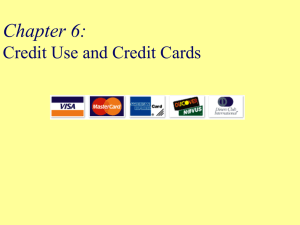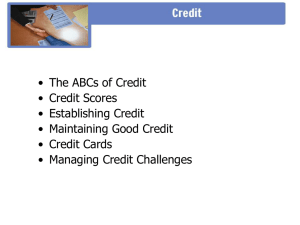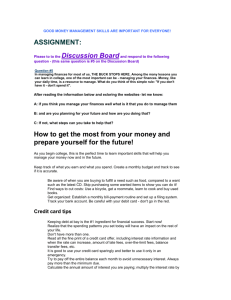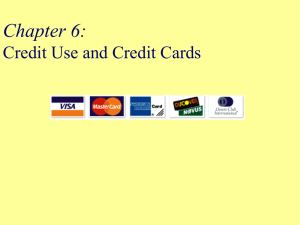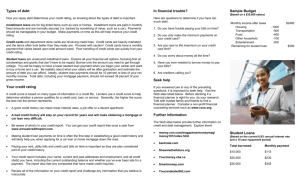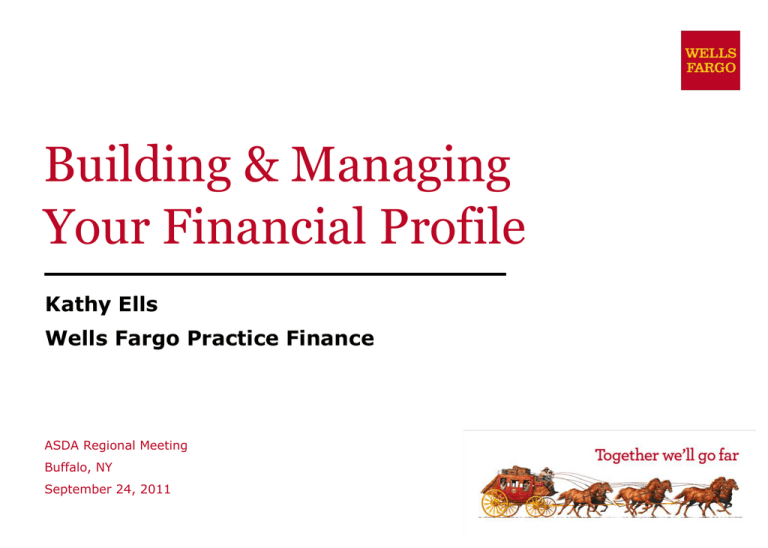
Building & Managing
Your Financial Profile
Kathy Ells
Wells Fargo Practice Finance
ASDA Regional Meeting
Buffalo, NY
September 24, 2011
Today’s topics
The importance of maintaining excellent personal
credit
How your credit score is calculated
Actions that can ruin your credit score
Steps to building a healthy financial profile
Maintaining excellent
personal credit
Ask yourself:
Is my credit strong enough to allow me to
start or purchase my own practice?
What does my credit history tell a lender?
About credit
Credit allows you to borrow tomorrow’s money to
pay for something today
Credit is a privilege – not a right
Importance of healthy credit
Good credit = the basis of all your financial
investments
Buying / building a practice
Buying / building a home
Vehicle purchases
Personal lifestyle choices
Boats, second homes, RVs
Importance of healthy credit
Lenders use credit reports to determine:
Who qualifies for a loan
At what interest rate
At what credit limits
Importance of healthy credit
Other companies use credit reports to judge level of
individual risk / responsibility:
Mobile phone companies
Insurance companies
Employers
Landlords
Importance of healthy credit
Credit reports
List of debts
Payment history
Public record information
Inquiries about your credit worthiness
Credit impact on
business loans
Credit impact on business loans
Most critical to your lender:
Personal debt
Student loans
Credit cards
Lines of credit
Overall credit rating based on:
Amount of total debt
Timeliness of monthly payments
Credit impact on business loans
Practice acquisition loan credit decision based on
Practice cash flow
Your ability to repay the loan while covering expenses &
lifestyle
Practice start-up loan credit decision based on
Your debt-to-income ratio
Credit impact on business loans
Practice acquisition & start-up loans
Low level of debt generally means:
Higher credit limit / Lower interest rate
High debt generally means:
Lower credit limit / Higher interest rate
How credit affects interest rate
Credit score
Rate
Practice loan payment*
770 +
6.88%
$3,465
730
7.30%
$3,530 ($7,800)
700
7.71%
$3,594 ($15,480)
660
8.53%
$3,724 ($31,080)
Below 650
Applicant may not be approved for credit
* Payments based on a 10 year, $300,000 practice loan
Credit impact on business loans
Lower credit limit / higher interest rate =
Less money to purchase / start a practice
Less ability to develop a competitive operation
Fewer funds for start-up salaries, marketing, overhead
Less profit due to higher loan expenses
Potentially decreased opportunity for success
Credit impact on business loans
Good credit is critical to your ultimate personal &
business success
The good news: You can build & manage your credit
profile
How credit scores
are calculated
How credit scores are calculated
FICO (formerly Fair Isaac Corporation) score:
A numerical expression representing your credit worthiness
Based on statistical analysis of your credit files
Primarily used in credit reports accessed by lenders, other
companies
How credit scores are calculated
Credit scores range from 350-850
723 is median score for Americans*
Scores below 600 considered high risk borrowers
620 = dividing line between “good” and “bad”
640+ = “pretty good”
720+ = “excellent”
* Source: www.creditscoring.com/average/
Five factors for calculating credit scores
Credit factor
% of
total
score
Payment history
35%
Have you made your payments on time?
Outstanding debt
30%
How much do you owe?
Credit history
15%
What is length of your credit history?
Pursuit of new credit
10%
Have you made numerous applications
for new credit?
Are you taking on more debt?
Types of credit in use
10%
Do you use a variety of credit types?
Source: www.myfico.com/crediteducation/whatsinyourscore.aspx
Considerations for improving
your score
National distribution of credit scores, 2010
45%
40%
40%
35%
30%
25%
20%
18%
15%
15%
10%
15%
12%
5%
0%
750 - 850
700 - 749
650 - 699
600 - 649
What score is too low for consideration?
Source: www.creditscoring.com/average/
300 - 599
How credit scores are calculated
• People with same credit score can have very
different credit profiles
- More or fewer accounts
- Different mix of accounts
- Longer or shorter credit history
- Use of more or less of available credit
• The same action can have different effects on people
with the same score
Five actions that can
ruin your credit score
Actions that can ruin your score
Maximized credit card
30-day late payment
Debt settlement
Foreclosure
Bankruptcy
Five credit score killers
1. Maxing out a credit card
Puts you at risk of over-limit fees
Considered a sign you are getting in over your head
Doesn’t matter to score formula if you carry a balance or
pay off the card when you get your bill
Action: Don’t use all credit available to you
Source: FICO; 5 Ways to Kill Your Credit Scores, Liz Pulliam Weston, MSN Money, November 12, 2009
Five credit score killers
2. Skipping a payment
Problem if you miss entire payment cycle
Can drop a good borrower with a 680 score into subprime
credit territory
Action: Set up automatic payments if possible to
avoid big drop in score from overlooked payment
Source: FICO; 5 Ways to Kill Your Credit Scores, Liz Pulliam Weston, MSN Money, November 12, 2009
Five credit score killers
3. Settling a credit card debt
Debt settlement negotiations can drag on for months
Each missed payment takes another bite out of your score
Amount of debt your creditor “forgives” is typically added
to taxable income
Action: Try working out a payment plan rather than
settling debt
Source: FICO; 5 Ways to Kill Your Credit Scores, Liz Pulliam Weston, MSN Money, November 12, 2009
Five credit score killers
4. Losing a property to foreclosure
Severe blow to your credit score
Implications for your future ability to get a mortgage
• Lenders may not extend another home loan for 2-4 years
Source: FICO; 5 Ways to Kill Your Credit Scores, Liz Pulliam Weston, MSN Money, November 12, 2009
Five credit score killers
5. Filing for bankruptcy
Called the “nuclear bomb” of credit actions
Both higher and lower scorers end up near bottom
Getting new credit extremely difficult
Action: Explore other possibilities: forbearance,
credit counseling, debt settlement
Source: FICO; 5 Ways to Kill Your Credit Scores, Liz Pulliam Weston, MSN Money, November 12, 2009
10 steps to a healthy
financial profile
10 steps to a healthy financial profile
1. Maintain at least 2-3 different types of credit
accounts
Revolving loans
• Credit cards / lines of credit
Installment loans
• Mortgages / auto loans / personal loans
Indicates you are credit worthy & able to manage debt
10 steps to a healthy financial profile
2. Avoid applying for credit from too many
sources
Multiple credit inquiries negatively impact credit rating
Especially within a short timeframe
10 steps to a healthy financial profile
3. Demonstrate you can use credit wisely
Do not use all the credit available to you
• Below 30% utilization is good
• Below 10% is better
10 steps to a healthy financial profile
4. Make on-time monthly payments
Always!
On credit cards, mortgages, installment loans, student
loans
Remember: Most service providers do report late
payments/collections to credit bureaus
• Cell phone companies, health clubs, medical offices, others
10 steps to a healthy financial profile
5. Consolidate personal loans
Can improve your cash flow
Generates a better financial profile
10 steps to a healthy financial profile
6. Continue payments during dispute
If in dispute with a creditor, continue to make minimum
monthly payments while you work towards a resolution
• Shows good will
• Preserves credit rating
10 steps to a healthy financial profile
7. Notify creditors in writing of your address
change
Ensures statements reach you promptly following a move
No “forgiveness” by credit bureaus for lost bills / delayed
payments during a move
10 steps to a healthy financial profile
8. Avoid co-signing and/or guarantying a loan
for friends or family members
Has the same impact on your credit as if you were the
primary borrower
Uncontrollable risk to your credit standing
10 steps to a healthy financial profile
9. Protect your identity
Review your credit report at least once a year
www.annualcreditreport.com
www.experian.com
www.transunion.com
www.equifax.com
Inform all credit bureaus of any discrepancies in writing
10 steps to a healthy financial profile
10. Keep copies of all relevant documents
Agreements / documents clearing judgments or liens
Letters from creditors clearing incorrect information
reported on loan history
Remember: All credit information stays in your records for
up to 10 years
In summary
Your credit profile forms the basis of all your
financial investments
An inadequate profile can cost you money in higher
interest rates and lower credit limits
A poor profile can impact your ability to build a solid
foundation for practice success
You have control over the quality of your financial
profile
Thank you
Kathy Ells
Wells Fargo Practice Finance
wellsfargo.com/dentist
© 2011 Wells Fargo Bank N.A. All rights reserved. Wells Fargo Practice Finance is a division of Wells Fargo Bank, N.A. For public use.
Presentation materials are provided for general information only and do not constitute, nor are they intended as, a substitute for consultation with accounting, tax, legal
or other professional advisors.




